Husqvarna DRT 900 User Manual

DRT 900
Owner's Manual / 96093000801 / 2009-04
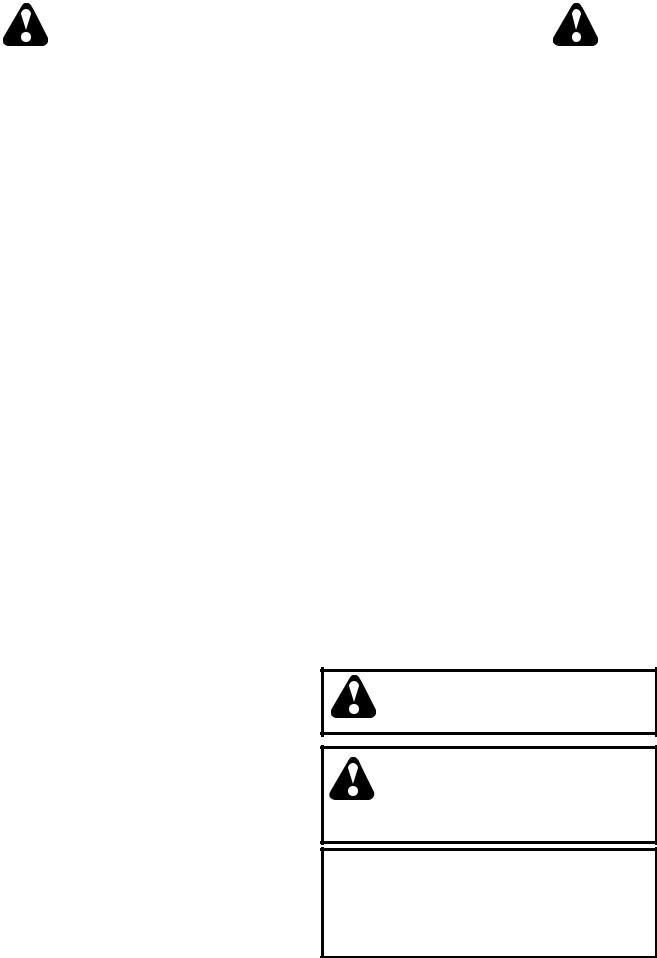
SAFETY RULES
Safe Operation Practices for Walk-Behind Powered Rotary Tillers
TRAINING
•Read the Manual carefully. Be thoroughly familiar with the controls and the proper use of the equipment. Know how to stop the unit and disengage the controls quickly.
•Never allow children to operate the equipment. Never allow adults to operate the equipment without proper instruction.
•Keep the area of operation clear of all persons, particularly small children, and pets.
•Never operate the tiller without proper guards, plates, or other safety protective devices in place.
•Keep children and pets away.
•Do not overload the machine capacity by attempting to till too deep at too fast a rate.
•Never operate the machine at high speeds on slippery surfaces. Look behind and use care when backing.
•Never allow bystanders near the unit.
•Use only attachments and accessories approved by the manufacturer of the tiller.
PREPARATION
•Thoroughly inspect the area where the equipment is to be used and remove all foreign objects.
•Disengage all clutches and shift into neutral before starting the engine (motor).
•Never operate the tiller without good visibility or light.
•Be careful when tilling in hard ground. The tines may catch in the ground and propel the tiller forward. If this occurs, let go of the handlebars and do not restrain the machine.
•Do not operate the equipment without wearing adequate outer garments. Wear footwear that will improve footing on slippery surfaces.
•Handle fuel with care; it is highly flammable.
•Use an approved fuel container.
•Never add fuel to a running engine or hot engine.
•Fill fuel tank outdoors with extreme care. Never fill fuel tank indoors.
•Replace gasoline cap securely and clean up spilled fuel before restarting.
•Use extension cords and receptacles as specified by the manufacturer for all units with electric drive motors or electric starting motors.
•Never attempt to make any adjustments while the engine (motor) is running (except where specifically recommended by manufacturer).
OPERATION
•Do not put hands or feet near or under rotating parts.
•Exercise extreme caution when operating on or crossing gravel drives, walks, or roads. Stay alert for hidden hazards or traffic. Do not carry passengers.
•After striking a foreign object, stop the engine (motor), remove the wire from the spark plug, thoroughly inspect the tiller for any damage, and repair the damage before restarting and operating the tiller.
•Exercise caution to avoid slipping or falling.
•If the unit should start to vibrate abnormally, stop the engine (motor) and check immediately for the cause. Vibration is generally a warning of trouble.
•Stop the engine (motor) when leaving the operating position.
•Take all possible precautions when leaving the machine unattended. Disengage the tines, shift into neutral, and stop the engine.
•Before cleaning, repairing, or inspecting, shut off the engine and make certain all moving parts have stopped. Disconnect the spark plug wire, and keep the wire away from the plug to prevent accidental starting. Disconnect the cord on electric motors.
•Do not run the engine indoors; exhaust fumes are dangerous.
2
MAINTENANCE AND STORAGE
•Keep machine, attachments, and accessories in safe working condition.
•Check shear pins, engine mounting bolts, and other bolts at frequent intervals for proper tightness to be sure the equipment is in safe working condition.
•Never store the machine with fuel in the fuel tank inside a building where ignition sources are present, such as hot water and space heaters, clothes dryers, and the like. Allow the engine to cool before storing in any enclosure.
•Always refer to the operator’s guide instructions for important details if the tiller is to be stored for an extended period.
- IMPORTANT -
CAUTIONS, IMPORTANTS, AND NOTES ARE A MEANS OF ATTRACTING ATTENTION TO IMPORTANT OR CRITICAL INFORMATION IN THIS MANUAL.
IMPORTANT: USED TO ALERT YOU THAT THERE IS A POSSIBILITY OF DAMAGING THIS EQUIPMENT.
NOTE: Gives essential information that will aid you to better understand, incorporate, or execute a particular set of instructions.
Look for this symbol to point out important safety precautions. It means CAUTION!!! BECOME ALERT!!! YOUR SAFETY IS INVOLVED.
CAUTION: Always disconnect spark plug wire and place wire where it cannot contact spark plug in order to prevent accidental starting when setting up, transporting, adjusting or making repairs.
 WARNING
WARNING
The engine exhaust from this product contains chemicals known to the State of California to cause cancer, birth defects, or other reproductive harm.

PRODUCT SPECIFICATIONS
Gasolina Capacity: |
3 Quarts (2.8L) |
|
Unleaded Regular |
|
|
Oil (API-SG-SL): |
SAE 30 (Above 32°F) |
(Capacity: 20 oz./0.6L) |
SAE 5W-30 (Below 32°F) |
|
|
Spark Plug : |
NGK-BPR6ES |
(Gap: .030"/0.76mm) |
TORCH-F6RTC |
|
|
CONGRATULATIONS on your purchase of a new tiller. It has been designed, engineered and manufactured to give you the best possible dependability and performance.
Should you experience any problems you cannot easily remedy, please contact your nearest authorized service center. We have competent, well-trained technicians and the proper tools to service or repair this unit.
Please read and retain this manual. The instructions will enable you to assemble and maintain your tiller properly. Always observe the “SAFETY RULES”.
CUSTOMER RESPONSIBILITIES
•Read and observe the safety rules.
•Follow a regular schedule in maintaining, caring for and using your tiller.
•Follow instructions under “Maintenance” and “Storage” sections of this Owner’s Manual.
WARNING: This unit is equipped with an internal combustion engine and should not be used on or near any unimprovedforest-covered,brush-coveredorgrasscovered land unless the engine's exhaust system is equipped with a spark arrester meeting applicable local laws (if any). If a spark arrester is used, it should be maintained in effective working order by the operator.
In the state of California, a spark arrester is required by law (Section 4442 of the California Public Resources Code). Other states may have similar laws. Federal laws apply on federal lands. See your authorized service center/ DEPARTMENT for spark arrester.
TABLE OF CONTENTS
SAFETY RULES .......................................................... |
2 |
CUSTOMER RESPONSIBILITIES............................... |
3 |
PRODUCT SPECIFICATIONS..................................... |
3 |
ASSEMBLY............................................................... |
4-6 |
OPERATION ........................................................... |
7-11 |
MAINTENANCE SCHEDULE .................................... |
12 |
MAINTENANCE ................................................... |
12-14 |
SERVICE & ADJUSTMENTS ............................... |
15-17 |
STORAGE.................................................................. |
18 |
TROUBLESHOOTING............................................... |
19 |
REPAIR PARTS .................................................... |
20-26 |
WARRANTY........................................... |
BACK COVER |
3

ASSEMBLY
Your new tiller has been assembled at the factory with exception of those parts left unassembled for shipping purposes. To ensure safe and proper operation of your tiller all parts and hardware you assemble must be tightened securely. Use the correct tools as necessary to insure proper tightness.
TOOLS REQUIRED FOR ASSEMBLY
A socket wrench set will make assembly easier. Standard wrench sizes are listed.
(1) Utility knife
(1) Tire pressure gauge
(1) Pair of pliers
(1) 9/16" wrench
OPERATOR’S POSITION (See Fig. 1)
When right or left hand is mentioned in this manual, it means when you are in the operating position (standing behind tiller handles).
FRONT
LEFT  RIGHT
RIGHT
OPERATOR’S
POSITION
Fig. 1
CONTENTS OF HARDWARE PACK |
|
|
(2) Handle Locks |
(1) Carriage Bolt |
(1) Center Locknut |
|
3/8-16 UNC x 1 Grade 5 |
3/8-16 UNC |
(1) Flat Washer 13/32 x 1 x 11 Gauge |
(1) Handle Lock Lever |
(1) Hairpin Clip |
(1) Pivot Bolt |
|
|
3/8-16 UNC Grade 5 |
Extra Shear Pins & Clips |
|
|
4 |
|
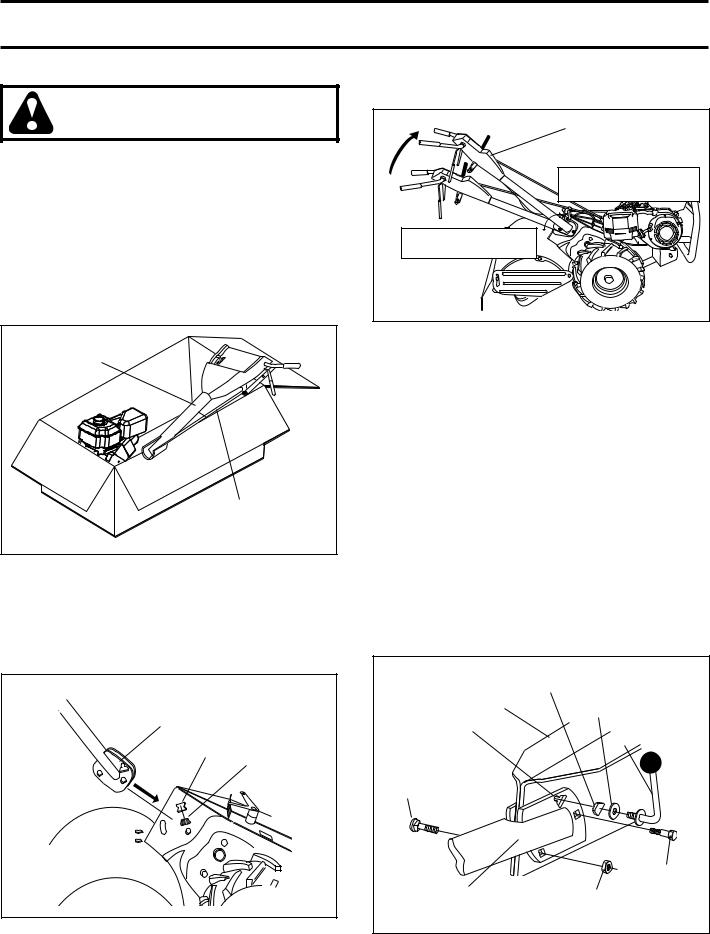
ASSEMBLY
UNPACKING CARTON (See Fig. 2)
CAUTION: Be careful of exposed staples when handling or disposing of cartoning material.
IMPORTANT: WHEN UNPACKING AND ASSEMBLING TILLER, BE CAREFUL NOT TO STRETCH OR KINK CABLES.
•While holding handle assembly, cut cable ties securing handle assembly to top frame and depth stake. Let handle assembly rest on tiller.
•Remove top frame of carton.
•Slowly ease handle assembly up and place on top of carton.
•Cut down right hand front and right hand rear corners of carton, lay side carton wall down.
•Remove packing material from handle assembly.
HANDLE |
|
|
|
ASSEMBLY |
|
|
|
|
|
|
3 |
|
|
_ |
|
|
n |
|
|
|
to |
|
|
ar |
|
|
|
c |
|
|
|
SHIFT ROD |
|||
Fig. 2
INSTALL HANDLE (See Figs. 3, 4, and 5)
•Insert one handle lock (with teeth facing outward) in gearcase notch. (Apply grease on smooth side of handle lock to aid in keeping lock in place until handle assembly is lowered into position.)
VIEWED FROM R.H. SIDE OF TILLER
HANDLE ASSEMBLY
GEARCASE
NOTCH
HANDLE
LOCK
Fig. 3
•Grasp handle assembly. Hold in “up” position. Be sure handle lock remains in gearcase notch. Slide handle assembly into position.
HANDLE ASSEMBLY |
"UP" POSITION |
TIGHTEN HANDLE LOCK |
LEVER TO HOLD |
LOOSEN HANDLE |
LOCK LEVER TO MOVE |
Fig. 4
•Rotate handle assembly down. Insert rear carriage bolt first, with bolt head on L.H. side of tiller and loosely assemble locknut (See Fig. 5).
•Insert pivot bolt in front part of plate and tighten.
•Cut down remaining corners of carton and lay panels flat.
•Lower the handle assembly. Tighten nut on carriage bolt so handle moves with some resistance. This will allow for easier adjustment.
•Place flat washer on threaded end of handle lock lever.
•Insert handle lock lever through handle base and gearcase. Screw in handle lock lever just enough to hold lever in place.
•Insert second handle lock (with teeth inward) in the slot of the handle base (just inside of washer).
•With handle assembly in lowest position, securely tighten handle lock lever by rotating clockwise. Leaving handle assembly in lowest position will make it easier to remove tiller from carton.
|
|
HANDLE |
|
|
LOCK |
GEARCASE |
FLAT |
|
|
|
WASHER |
SLOT |
|
HANDLE LOCK |
|
|
|
|
|
LEVER |
CARRIAGE |
|
|
BOLT |
|
|
|
4 |
|
_3 |
PIVOT BOLT |
|
dles |
|
|
han |
|
|
|
|
|
HANDLE |
|
LOCKNUT |
BASE |
|
|
Fig. 5
5
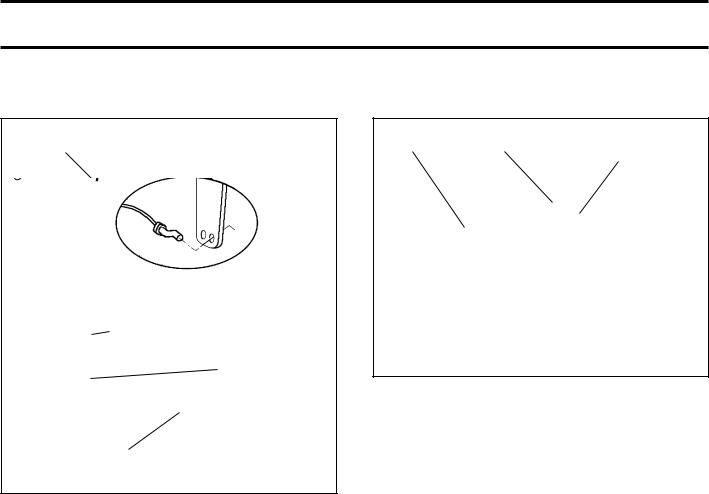
ASSEMBLY
ATTACH CLUTCH CABLE (See Fig. 6)
•Hook end of clutch cable through hole in control bar bracket.
CONTROL BAR
BRACKET
END OF CLUTCH
CABLE
Fig. 6
CONNECT SHIFT ROD (See Fig. 7)
•Insert end of shift rod into hole of shift lever indicator.
•Insert hairpin clip through hole of shift rod to secure.
SHIFT |
HAIRPIN |
SHIFT |
|
CLIP |
LEVER |
||
ROD |
|||
|
INDICATOR |
||
|
|
Fig. 7
REMOVE TILLER FROM CRATE
•Make sure shift lever indicator is in “N” position (See Fig. 7)
•Tilt tiller forward by lifting handle. Separate cardboard cover from leveling shield.
•Rotate tiller handle to the right and pull tiller out of carton.
CHECK TIRE PRESSURE
The tires on your unit were overinflated at the factory for shipping purposes. Correct and equal tire pressure is important for best tilling performance.
•Reduce tire pressure to 20 PSI (1.4 kg/cm2).
HANDLE HEIGHT
•Handle height may be adjusted to better suit operator. (See “TO ADJUST HANDLE HEIGHT” in the Service and Adjustments section of this manual).
6
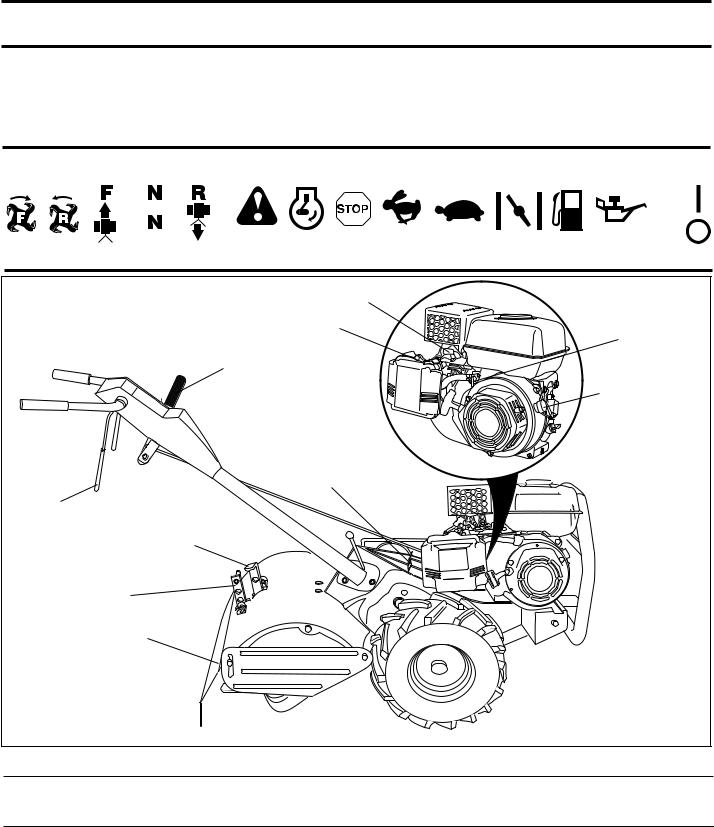
OPERATION
KNOW YOUR TILLER
READ THIS OWNER'S MANUAL AND SAFETY RULES BEFORE OPERATING YOUR TILLER.
Compare the illustrations with your tiller to familiarize yourself with the location of various controls and adjustments. Save this manual for future reference.
These symbols may appear on your Tiller or in literature supplied with the product. Learn and understand their meaning.
RUN
STOP
|
CAUTION |
ENGINE |
ENGINE |
FAST |
SLOW |
CHOKE |
FUEL |
OIL |
|
|
|
|
|
|
|||
TILLING |
TILLING FORWARD NEUTRAL REVERSE OR WARNING |
ON |
OFF |
|
|
|
|
|
THROTTLE CONTROL |
|
CHOKE CONTROL |
FUEL |
|
|
|
VALVE |
SHIFT LEVER |
|
|
ON/OFF |
|
SWITCH |
SHIFT LEVER INDICATOR |
|
DRIVE |
|
CONTROL |
|
BAR |
|
DRAG STAKE |
|
DEPTH STAKE |
|
LEVELING |
|
SHIELD |
|
Fig. 8
MEETS ANSI SAFETY REQUIREMENTS
Our tillers conform to the safety standards of the American National Standards Institute.
CHOKE CONTROL - Used when starting a cold engine. DEPTH STAKE - Controls depth at which tiller will dig.
DRAG STAKE - Controls forward speed in forward rotating till position.
DRIVE CONTROL BAR - Used to engage tines. LEVELING SHIELD - Levels tilled soil.
ON / OFF SWITCH - used to STOP the engine.
FUEL VALVE - Used to turn fuel off and on.
RECOIL STARTER HANDLE - Used to start the engine. SHIFT LEVER - Used to shift transmission gears.
SHIFT LEVER INDICATOR - Shows which gear the transmission is in.
THROTTLE CONTROL - Controls engine speed.
7
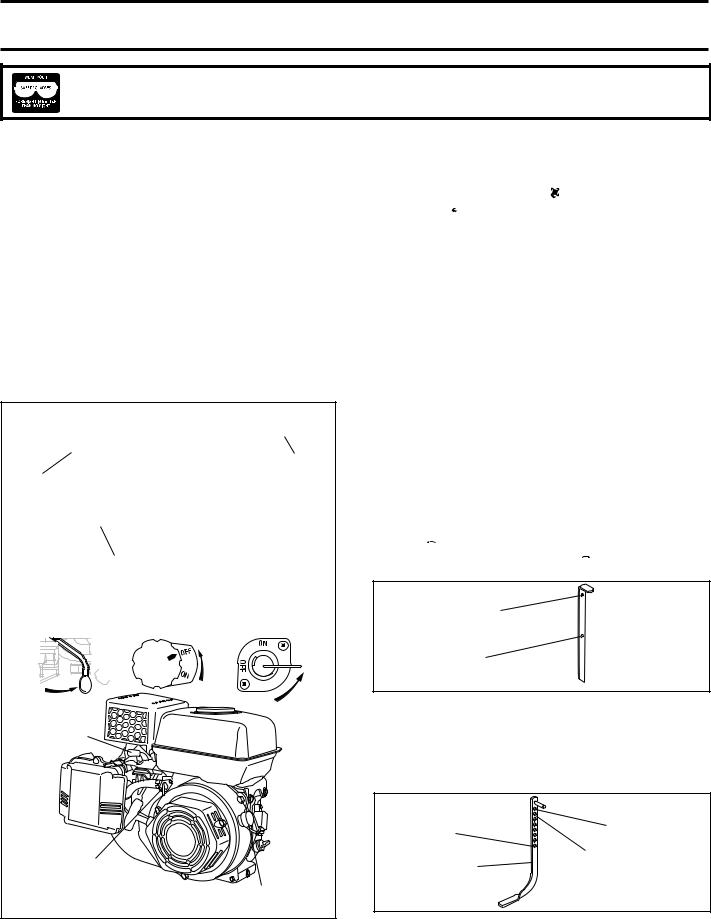
OPERATION
The operation of any tiller can result in foreign objects thrown into the eyes, which can result in severe eye damage. Always wear safety glasses or eye shields before starting your tiller and while tilling. We recommend a wide vision safety mask for over spectacles or standard safety glasses.
00155
HOW TO USE YOUR TILLER
Know how to operate all controls before adding fuel and oil or attempting to start engine.
STOPPING (See Fig. 9)
TINES
1.Release drive control to stop movement.
2.Move shift lever to “N” (neutral) position.
ENGINE
2.Move throttle control to “SLOW” position and allow the engine to run slowly for cool down.
3.Turn the engine switch to the "OFF" Position.
4.Turn the fuel valve lever to the "OFF" Position.
NOTE: NEVER USE CHOKE TO STOP ENGINE.
IMPORTANT: TO STOP ENGINE IN AN EMERGENCY, TURN THE ENGINE SWITCH TO THE OFF POSITION.
|
|
SHIFT |
|
|
LEVER |
DRIVE CONTROL |
|
|
BAR |
|
|
“ENGAGED” |
|
|
POSITION |
|
|
DRIVE CONTROL BAR |
|
|
“DISENGAGED” POSITION |
|
|
THROTTLE |
ENGINE |
FUEL |
CONTROL |
SWITCH |
VALVE |
THROTTLE |
|
|
CONTROL |
|
|
FUEL |
|
|
VALVE |
|
|
|
|
ENGINE |
|
|
SWITCH |
Fig. 9
TINE OPERATION - WITH WHEEL DRIVE
Always release drive control bar before moving shift lever into another position.
•Tine movement is achieved by moving shift lever to
either the counter rotating (
 ) till position or the forward rotating (
) till position or the forward rotating (

 ) till position and engaging drive control bar.
) till position and engaging drive control bar.
FORWARD - WHEELS ONLY/TINES STOPPED
•Release drive control bar and move shift lever indicator to “F” (forward) position. Engage drive control bar and tiller will move forward.
REVERSE - WHEELS ONLY/TINES STOPPED
•DO NOT STAND DIRECTLY BEHIND TILLER.
•Release the drive control bar.
•Move throttle control to “SLOW” position.
•Move shift lever indicator to “R” (reverse) position.
•Hold drive control bar against the handle to start tiller movement.
HARD TO SHIFT GEARS
•Briefly engage drive control bar and release or rock tiller forward and backward until are able to shift gears.
DRAG STAKE (See Fig. 10)
The drag stake should be raised when tilling in the counter rotating ( ) till position. The drag stake should be lowered when tilling in the forward rotating (
) till position. The drag stake should be lowered when tilling in the forward rotating (

 )till position.
)till position.
LOWERED (FORWARD ROTATING TILL)
RAISED |
|
(COUNTER ROTATING |
at ke_10 |
TILL) |
pth_s |
|
de |
Fig. 10
DEPTH STAKE (See Fig. 11)
The depth stake can be raised or lowered to allow you more versatile tilling and cultivating, or to more easily transport your tiller.
DEEPEST |
TRANSPORT |
|
POSITION |
||
TILLING |
|
|
DEPTH |
SHALLOWEST |
|
TILLING |
||
STAKE |
||
(CULTIVATING) |
||
|
||
|
2 |
|
|
e_ |
|
|
tak |
|
|
_s |
|
|
pth |
|
|
de |
Fig. 11
8
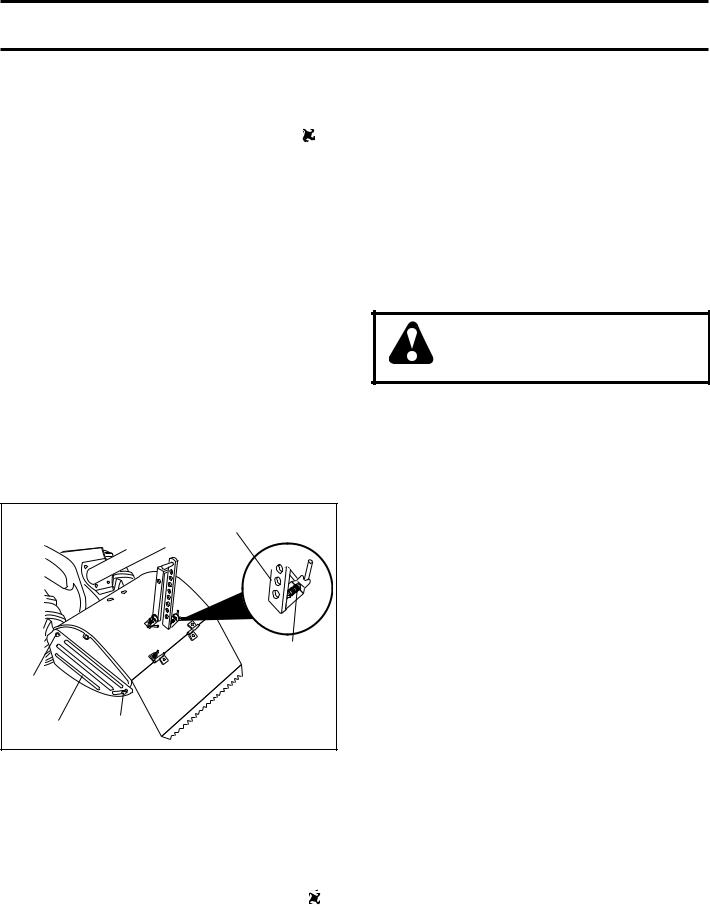
OPERATION
TILLING (See Fig. 12)
•Release depth stake pin. Pull the depth stake up for increased tilling depth. Place depth stake pin in hole of depth stake to lock in position.
•Place shift lever indicator in counter rotating 
 ) till
) till
position.
•Hold the drive control bar against the handle to start tilling movement. Tines and wheels will both turn.
•Move throttle control to “FAST” position for deep tilling. To cultivate, throttle control can be set at any desired speed, depending on how fast or slow you wish to cultivate.
IMPORTANT: ALWAYS RELEASE DRIVE CONTROL BAR BEFORE MOVING SHIFT LEVER INTO ANOTHER POSITION.
TURNING
•Release the drive control bar.
•Move throttle control to “SLOW” position.
•Place shift lever indicator in “F” (forward) position. Tines will not turn.
•Lift handle to raise tines out of ground.
•Swing the handle in the opposite direction you wish to turn, being careful to keep feet and legs away from tines.
•When you have completed your turn-around, release the drive control bar and lower handle. Place shift lever in (till) position and move throttle control to desired speed. To begin tilling, hold drive control bar against the handle.
|
|
DEPTH STAKE PIN |
|||
|
|
“RELEASED” POSITION |
|||
|
|
|
|
|
“LOCKED” |
|
|
|
|
|
POSITION |
NUT “B” |
|
|
|
|
|
OUTER |
NUT “A” |
|
|
|
11 |
|
|
_ |
|||
|
e |
|
|||
k |
|
|
|||
ta |
|
|
|
||
SIDE SHIELD |
|
s |
|
|
|
|
_ |
|
|
|
|
|
th |
|
|
|
|
|
p |
|
|
|
|
|
|
e |
|
|
|
|
|
d |
|
|
|
Fig. 12
CULTIVATING
•Use the forward rotating tine drive when cultivating, tilling soft ground or tilling pre-tilled soil.
•Release depth and drag stake pins. Lower drag stake. Pull the depth stake up for increased tilling depth. Place proper pin in hole of depth stake or drag stake to lock in position.
•Place shift lever indicator in forward rotating  )till position.
)till position.
•Hold the drive control bar against the handle to start tilling movement. Tines and wheels will both turn.
•Move throttle control "FAST" position for deep tilling. To cultivate, throttle control can be set at any desired speed, depending on how fast or slow you wish to cultivate.
•Always lower the drag stakewhenusing theforward rotating tine drive.
OUTER SIDE SHIELDS (See Fig. 12)
The back edges of the outer side shields are slotted so that the shields can be raised for deep tilling and lowered for shallow tilling to protect small plants from being buried. Loosen nut “A” in slot and nut “B”. Move shield to desired position (both sides). Retighten nuts.
TO TRANSPORT
CAUTION: Beforeliftingortransporting, allow tiller engine and muffler to cool. Disconnect spark plug wire. Drain gasoline from fuel tank.
AROUND THE YARD
•Release the depth stake pin. Move the depth stake down to the top hole for transporting the tiller. Place depth stake pin in hole of depth stake to lock in position. This prevents tines from scuffing the ground.
•Place shift lever indicator in “F” (forward) position for transporting.
•Hold the drive control bar against the handle to start tiller movement. Tines will not turn.
•Move throttle control to desired speed.
AROUND TOWN
•Disconnect spark plug wire.
•Drain fuel tank.
•Transport in upright position to prevent oil leakage.
BEFORE STARTING ENGINE
IMPORTANT: BE VERY CAREFUL NOT TO ALLOW DIRT TO ENTER THE ENGINE WHEN CHECKING OR ADDING OIL OR FUEL. USE CLEAN OIL AND FUEL AND STORE IN APPROVED, CLEAN, COVERED CONTAINERS. USE CLEAN FILL FUNNELS.
FILL ENGINE WITH OIL (See Fig. 13)
1.Remove hangtag from engine.
2.With engine level, remove engine oil filler plug.
3.Fill engine with oil to point of overflowing. For approximate capacity see “PRODUCT SPECIFICATIONS” on page 3 of this manual. All oil must meet A.P.I. Service Classification SG-SL.
4.Tilt tiller back on its wheels and then re-level.
5.With engine level, refill to point of overflowing if necessary. Replace oil filler plug.
•For cold weather operation you should change oil for easier starting (See “OIL VISCOSITY CHART” in the Maintenance section of this manual).
•To change engine oil, see the Maintenance section of this manual.
9
